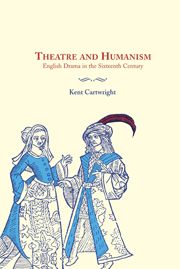Book contents
- Frontmatter
- Contents
- Acknowledgments
- Introduction
- 1 The humanism of acting: John Heywood's The Foure PP
- 2 Wit and Science and the dramaturgy of learning
- 3 Playing against type: Gammer Gurton's Needle
- 4 Time, tyranny, and suspense in political drama of the 1560s
- 5 Humanism and the dramatizing of women
- 6 The confusions of Gallathea: John Lyly as popular dramatist
- 7 Bearing witness to Tamburlaine, Part 1
- 8 Robert Green's Friar Bacon and Friar Bungay: the commonwealth of the present moment
- Afterword
- Notes
- Index
5 - Humanism and the dramatizing of women
Published online by Cambridge University Press: 22 September 2009
- Frontmatter
- Contents
- Acknowledgments
- Introduction
- 1 The humanism of acting: John Heywood's The Foure PP
- 2 Wit and Science and the dramaturgy of learning
- 3 Playing against type: Gammer Gurton's Needle
- 4 Time, tyranny, and suspense in political drama of the 1560s
- 5 Humanism and the dramatizing of women
- 6 The confusions of Gallathea: John Lyly as popular dramatist
- 7 Bearing witness to Tamburlaine, Part 1
- 8 Robert Green's Friar Bacon and Friar Bungay: the commonwealth of the present moment
- Afterword
- Notes
- Index
Summary
Medieval morality plays such as Mankind (c. 1470) or Medwall's Nature (c. 1495) present women as temptations to sin or as embodiments of virtue, but in sixteenth-century drama representations of women change from virgin and whore stereotypes to complex and engaging figures. How could that change happen? While Tudor popular theatre contains a full quota of bawds, shrews, scolds, and angelic virgins, its demonized or idealized women, a line of different, critically underappreciated female characters appears in humanist drama. Spanning the More circle interludes, the 1560s woman-centered plays, and the 1570s romances, these humanist theatrical works grant women personal and political influence, show them harmoniously combining male and female traits, and confer stage authority upon them. Stereotypical views of women permeate most sixteenth-century plays, but humanist dramaturgy nurtures female protagonists whose compelling stage presence – expressing griefs, doubts, private desires, and secret identities – contributes to the achievement in Renaissance theatre of individualized women characters.
Most critical discussions of women characters in “Renaissance Drama” limit themselves to Shakespeare and his contemporaries, dismissing earlier Tudor drama as patriarchal and repressive of women and postulating an Elizabethan misogyny whose “diverse legal, moral, popular, and medical discourses … link women's agency to transgression.” Those views contain considerable justice. The popular morality and saints plays, for example, typically divide women into the opposing categories of whore and virgin.
- Type
- Chapter
- Information
- Theatre and HumanismEnglish Drama in the Sixteenth Century, pp. 135 - 166Publisher: Cambridge University PressPrint publication year: 1999



